Bruce Rodgers Connective Design
Posted on June 4, 2019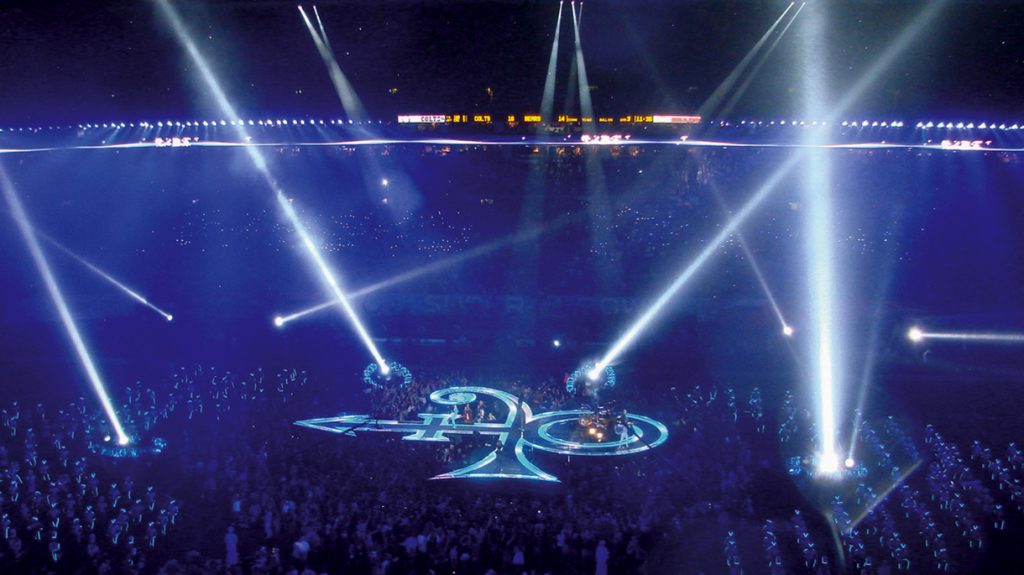
Prince, Super Bowl Halftime Performance 2007
The word “emotion” comes up often when this Connecticut-based production designer talks about the creative process that drives his work, whether it be on a Super Bowl Halftime Show (he’s been involved in every one since 2007), or a smaller, more intimate project. This is why hand-drawn sketches have always been a part of his design routine, joined later of course by the most advanced digital rendering software available.
Taking pencil to paper at the start of a project strips away distractions, removing (or at least lowering) the barriers that separate Rodgers from the core feelings that will ultimately lie at the heart of his design. Tapping into this emotional essence invariably leads to a design that strengthens the connection between artist and audience, as was very evident in Rodgers’ first Super Bowl Halftime, when he and his team opened a vista between Prince and the fans at Dolphin Stadium, so the millions watching on TV felt as if they were experiencing a live event with all its emotional impact.
Being opened to inspiration, Rodgers often finds it in unexpected places. While staying at the Mayflower Hotel in Washington, D.C., he saw a photo of Ricky Martin on the cover of Rolling Stone. This ultimately led him to design a set for the Livin’ La Vida Loca tour that was based on a giant 3D portrait of the Latin Star.
Although emotion and flashes of inspiration ignite the creative spark, ultimately it is collaboration that pulls all the disparate pieces together into a complete design. Rodgers is quick to credit his collaborators with contributing to his achievements. Included in this group is a long list of celebrated lighting designers. Working with them, Rodgers has done the production design for memorable works like Madonna’s Drowned World Tour, the Jay-Z and Eminem concert at Yankee Stadium, and President Barack Obama’s acceptance speech at Invesco Field in Denver. The principal of Tribe, Inc. he spoke to us about the passion and purpose of design.
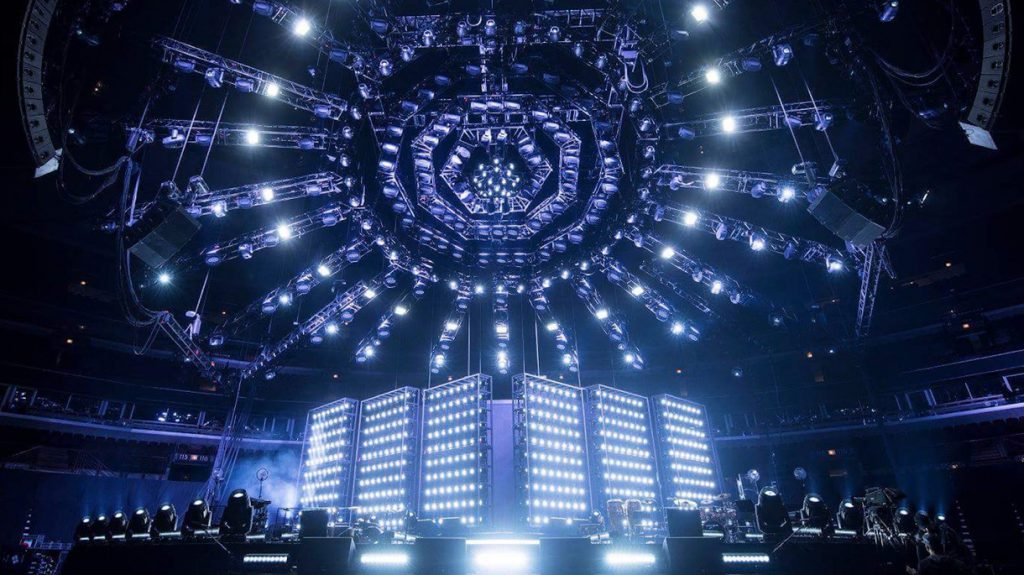
Romeo Santos’ Golden Tour 2018
In 2018, you added a new item to your resume when you took on the role of lighting designer for Romeo Santos’ Golden Tour. Why did you decide to do this after years as a preeminent production designer?
“The opportunity fell into my lap on this one. In the beginning of a show design process I’m always asked to provide concept sketches, and I try to sketch in the lighting and FX vibe to sell the overall scenic look. A good friend of mine, Roy Bennet, always said you can’t have light without darkness, and I always say you can’t have scenery without light. I love sketching heroic feeling into my scenes with light and fire. I love lifting up the performers and supporting their message and Romeo’s Golden SunBurst set was a great example of doing that with light.
“Another reason I felt comfortable jumping into the LD role with Romeo is he allowed me to bring in his long-time designer Jorge Caraballo and my friend, designer Felix Peralta. They knew their way around the programming aspects and helped me make the design EPIC!
“I’ve been designing shows for 30 years and have been blessed to work with so many creative and gifted lighting, fx, scenic, content designers, show creators, producers and artists so I try to carry with me everything I’ve learned along the way. As a production designer you really are there to embrace and glue everything together to make one show.”
What surprised you most about sitting in the lighting designer’s chair?
“The amount of things I didn’t know, even after all my years. It made me appreciate my lighting friends and technicians more that I already did. Great lighting provides an emotional foundation to everything, and in live music great lighting helps the audience focus on the message so I was able to test some of my own theories in Romeo’s show.”
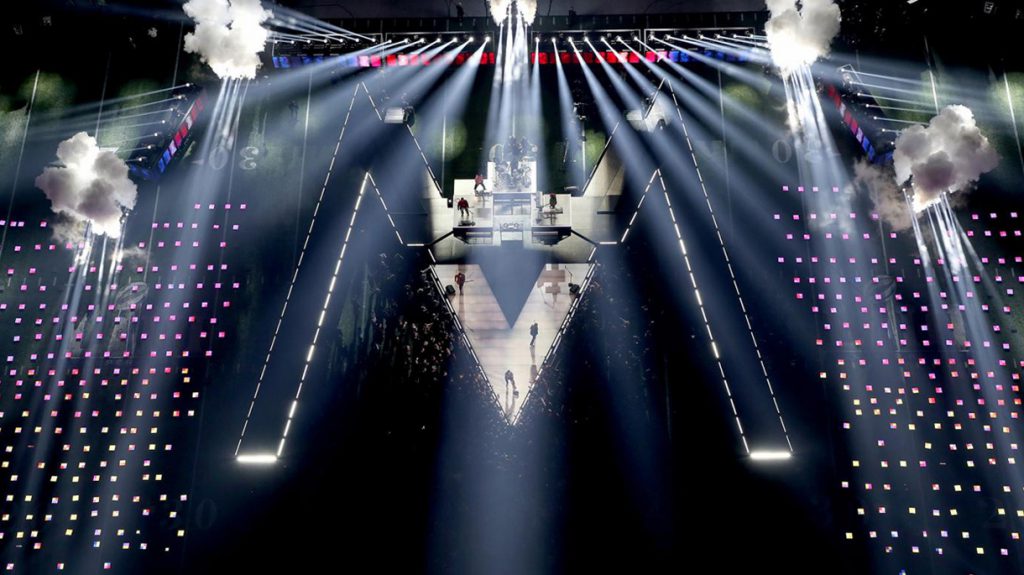
Maroon 5, Super Bowl Halftime Performance 2019
What’s the key to a successful production designer/lighting designer collaboration?
“In the case of Romeo’s show, I was both, so it was a nice collaboration. LOL. I’m pretty much an expert on this subject. I’ve had the honor to work with so many great lighting designers on a variety of shows and events big and small. From Patrick Woodroffe, to Allen Branton, Baz Halpin, Paul Guthrie, Candace Brightman, Bobby Dickinson, Roy Bennet, Stan Crocker, Bob Barnhart, Alan Adelman, Al Gurdon, Chris Reade, Marc Brickman, Willie Williams, Bob Peterson, Simon Miles, Chris Cockrill, Eric Cathcart, Bryan Hartley, Demfis Fyssicopulos, Fenton Williams, John Featherstone, Chris Medvitz, David Finn, Andy Knighton, John Maquire, Patrick Dierson, Steve Lieberman, Mac Mosier, Andre’ Petrus, Jon Kusner, Jesse Blevins, Peter Morse, Eric Marchwinski, Brian Jenkins, and Anne Militello. My list is long, and each designer is different and great in their own way. Their teams of programmers and directors are all superstars. Each collaboration different and special. The common key is communication and respect and protection of the collective goals. There’s no isolation of departments in a successful show design. It’s fun working with designers that have been around for a while.
“There is a perspective from the days where less was more and technology was simple or non-existent, so emotional design was from a real collaboration of performance and light. And on the other hand, it’s fun to put a band like The Who in a super modern setting like our Halftime Show design where we created a look with Ricky Kirshner’s team, lighting designer Al Gurdon, director Hamish Hamilton, and pyro designer Doug Adams to support the epic sounds of The Who before 130 million viewers.”
Something we’ve always been impressed by is how your production designs are truly three dimensional. You not only think in terms of length and width, but also of depth, so you have some very compelling scenic elements above the stage, as you did with the plane on Dierks Bentley’s Mountain High Tour. How important is it to incorporate the area above the stage into your design?
“Chris Reade and Dierks and I have been working together for almost 10 years and we have a lot of fun. That’s a tour design that plays in all kinds of venues which illustrates the main challenge of any live show design that moves from town to town. There are a few common things about most venues that you can rely on but the most important thing to design is flexibility, and the most important element in a good road show design is a touring team that is experienced with putting a complicated show in a tough venue. On the Dierks shows we have the talented Jay Ballinger and Tom Addison and their great team. On Chris Stapleton’s tour we have Clay Hunt and Zach Peters and their amazing crew. Two examples of different shows with the common denominator being strong, experienced management and crews. Once you understand the flexible volumn of space to design to and the various types of venues, you can fill the space as needed. Sightlines play a big part in the shaping of a set design too. And a big part of design is making sure you test yourself to find great design that is on par with the other designers in our industry. Today, worldwide, you’ll find amazing young designers that are taking everything to the next levels and beyond, so it’s fun to be in the mix.”
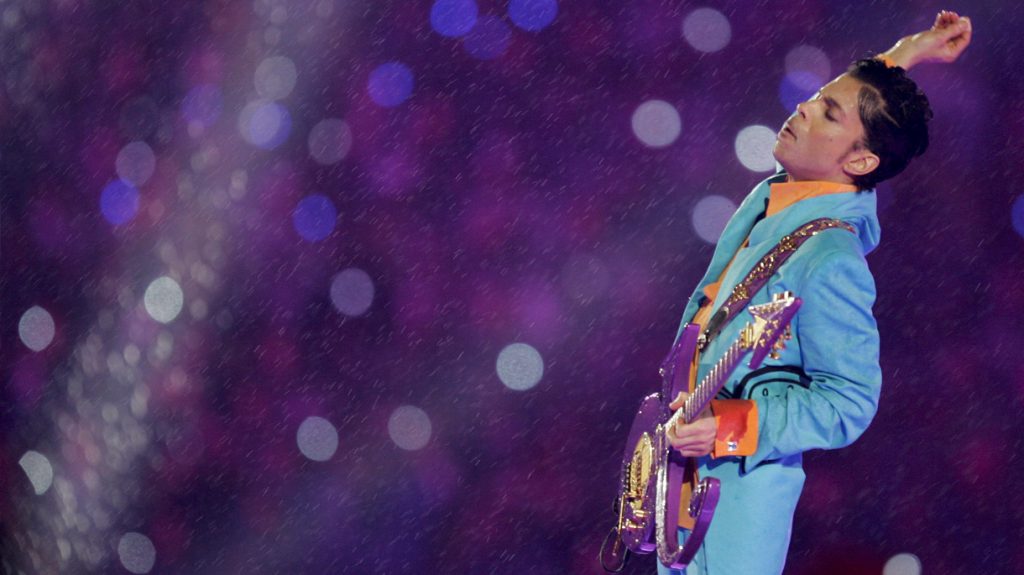
Prince, Super Bowl Halftime Performance 2007
You’ve designed every Super Bowl Halftime Show since 2007. You always seem to be raising the bar for yourself. How do you motivate yourself to take it to the next level?
“The Halftime team is an amazing group of driven people. My early shows were produced by Don Mischer, Ricky Kirshner and Glenn Weiss, and the last 10 have been produced by Ricky Kirshner. We always remind ourselves early in each design process that we’re a team. We have some very talented designers, technicians, staging and cast movement experts that are unmatched. It’s the reason we try to push ourselves to get something big and unique on the field in 7 minutes (the recent Maroon 5 design loaded in in 6 minutes 30 seconds). The caliber of Ricky’s team is so advanced that they expect a challenging show design and never settle for less since audience expectation runs so high. So my Halftime Show design motto is to challenge and satisfy our team and the results will make the audience happy.”
Your Super Bowl show with Prince was one of the most memorable. It was almost as if you ordered up the rain as part of your design. What do you remember most about that project?
“I was on a flight home after that show sitting in front with a bunch of people from ESPN and I overheard more than one whispered comment that we added Purple Rain as the finale song at the last minute due to the rain storm that night. Not true. That was my first Super Bowl Halftime Show, so I have vivid memories of that experience. From the initial sketches I wanted to open up the vista between Prince and the stadium audience to show the TV audience the connection I knew Prince would achieve. Don Mischer directed that show and we were able to connect the TV audience to that experience for that very reason. It wasn’t a TV shoot…it was a live experience that transcended to the TV audience. Design-wise, the only thing between Prince and the audience were massive spot light beams that I sketched in my concept presentation. I wanted to use beams as the scenery. I didn’t know those beams would create a twinkling misty atmosphere like it did in our rainy performance, but it happened, and I love to look at photos of that show with Prince in the midst of that kind of starry magical place. Fitting for such a singular artist as Prince.”
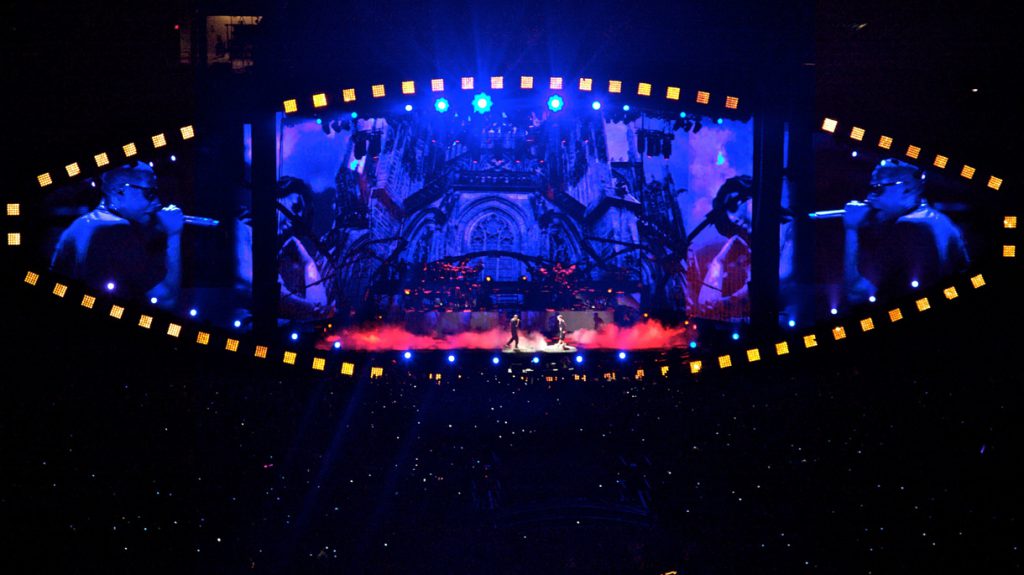
Jay-Z and Eminems’ Home and Home Tour 2010
Can you describe how you feel in the minutes leading up to the start of a Super Bowl Halftime Show?
“It’s an amazing feeling. And it can be hectic. Our teams are ready in the tunnels with a mile long train of show carts. Adrenaline is pumping. The live audience is ready to experience the install and the 12 minute show! I am in the TV truck, sitting, praying, waiting in my seat behind the director. To my right is Bob Dickinson on the Prince, Petty, Springsteen shows, Al Gurdon on The Who, Madonna and Beyoncé shows, Bob Barnhart on all the others. The first half of the game is winding down and nearing the 2-minute warning, which is the moment our teams get their game face on. At the end of the 2 minutes of game time we were allowed on the field to get our show installed within a 7-minute period. It’s a carefully choreographed sequence of movements, connections, etc. designed and rehearsed for months to make it a success by a very tightknit team.
“I remember describing to Madonna the concept of the 2-minute warning and how it could be exactly 2 minutes or stretch out to a half hour or more depending on the game situation, time outs, injuries, etc. and to pace herself in preparation for the start of the show. She did a good job keeping her patience and adrenaline at bay. To me this is the toughest part of the halftime experience for the great artists in this show.”
Why did you name your business Tribe, Inc.?
“We started Tribe in our back garage in Venice, Ca. in late 1996. Shelley Rodgers, Anton Goss, our friend Mike Rhodes and I designed the idea of our production design company based around the concept of the tribal gathering ritual in ancient and modern times. The constant is that the tribe depends on the ceremony. As example – The Foo Fighters collect a certain audience group and that audience then splinters to other ceremonies (events, concerts, etc.) as an entirely different audience group. Always organic and changing into specific groups / tribes for that given moment or event in time. It’s the way church works. Today’s kids don’t always go to church, most would rather go to Coachella. Our logo is that in a nutshell. An entity enters and leaves a given venue thru a sensitive and sometimes dangerous portal, much like an audience entering and exiting a venue. Careful at first in anticipation to participate. A lot of fun, deep thoughts happening in Venice back then, but the concepts still work for me.”
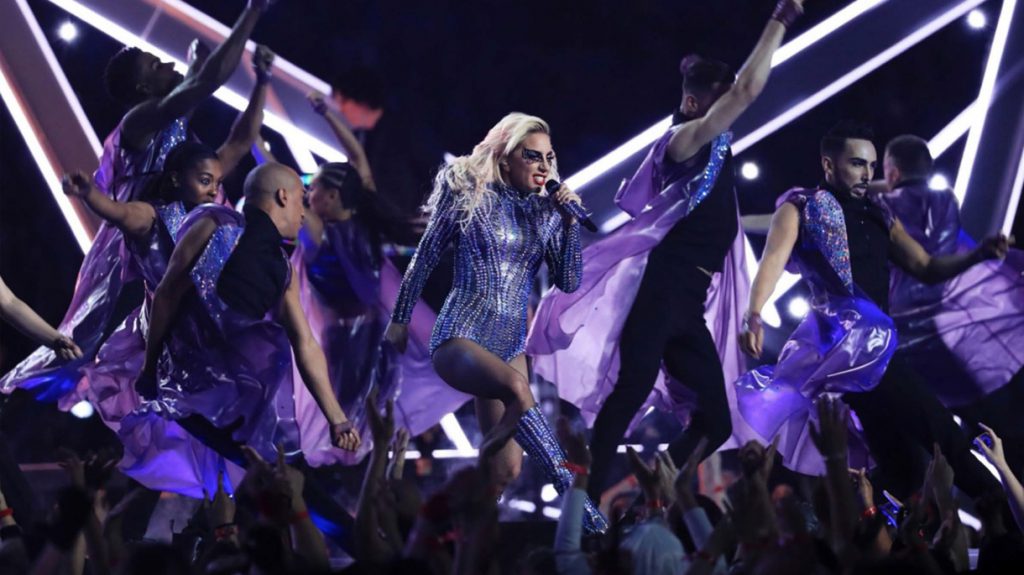
Lady Gaga, Super Bowl Halftime Performance 2017
How has the growth of video panels influenced your work as a production designer? And advice on incorporating panels in set designs?
“Video and LED technology is the industry I call the wild wild west, and with lighting has driven design for the last 20 years. Every year brings new technology and new possibilities to show design. It’s only getting better and smarter and more dependable. If you work with this kind of technology, you’ll be working in several budget levels, meaning you have to make something special with lesser technology budgets and make something even more advanced when your budgets are huge. It’s a big challenge, but there are a lot of video technology gurus and creatives out there blazing the trail blending imagery with light and turning on our very sophisticated audiences all over the world.”
You’re well-versed in design software, but you still like to include hand-drawn sketches in your design process. Why is that?
“When I first started in the business, everything was drawn or painted by hand and we made renderings and draftings and 3D models for presentations. In my first week of working in Hollywood I remember getting a fax from London, from Mark Fisher, on a project we were developing together, and the fax was an AutoCAD drafting his studio had drawn. It was like the dawn of man..ha-ha. I’ve managed to still hand sketch much of my work and enjoy blending hand sketching with computerized rendering software, Photoshop, C4D, etc. And I also enjoy hiring in new illustrators to help us with our design process. All of our CAD work is either VectorWorks or AutoCAD and lately we’re getting into SolidWorks and SketchUp.”
Having seen your self portrait, we know you’re a good artist. Do you have a favorite painter? Looking back in history, can you think of a painter who would have been a great production designer if he or she was around today?
“I love so many painters, artists, film makers, sculptors, architects and composers – NC, Andrew and James Wyeth, Thomas Hart Benton, Picasso, Serra, Kahlo, Pollock, the poet Robert Frost, are some of my favorites from my youth. Today, I’m enjoying the wave of amazing artists from Mexico and South America who are so mind blowing. From film to painting to architecture to philosophy, we’re in the midst of a real renaissance from the south of us that we should embrace.”
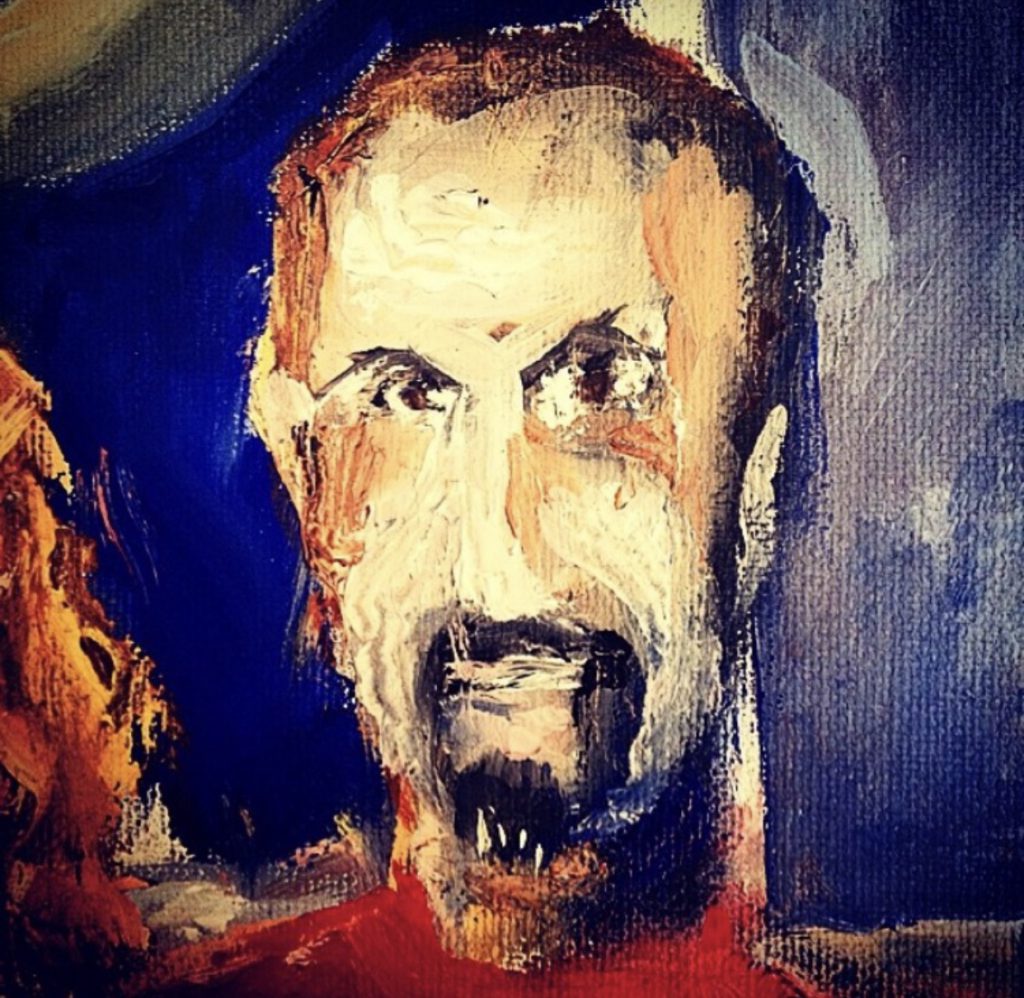
Bruce Rodgers Self-Portrait
You’ve said in the past that production design is an emotional process and reflects different things about your own history from growing up in Odessa, Texas and experiences since. What do your designs reflect about your life experiences?
“Odessa, Texas, aka Friday Night Lights in west Texas is where I’m from. The kind of place that requires you to look for the beauty in things. Lot’s of basics: not a lot of trees, but a massive amount of sky and different types of weather. Incredible lightning storms, sand storms, wind and rain and starry nights. Hard working people. My dad worked in the oil fields, so I remember visiting him at the refinery in Big Spring at night, and the feel of all that industrial architecture lit by various functional lighting had an impact on me. All the elements needed to inspire the younger me when we had nothing else to do but ponder the whys and what’s of life. Music was huge in our small house with competing styles playing constantly: Johnny Cash, Janis Joplin, Al Green, Pavarotti, Queen, Lou Reed, etc.
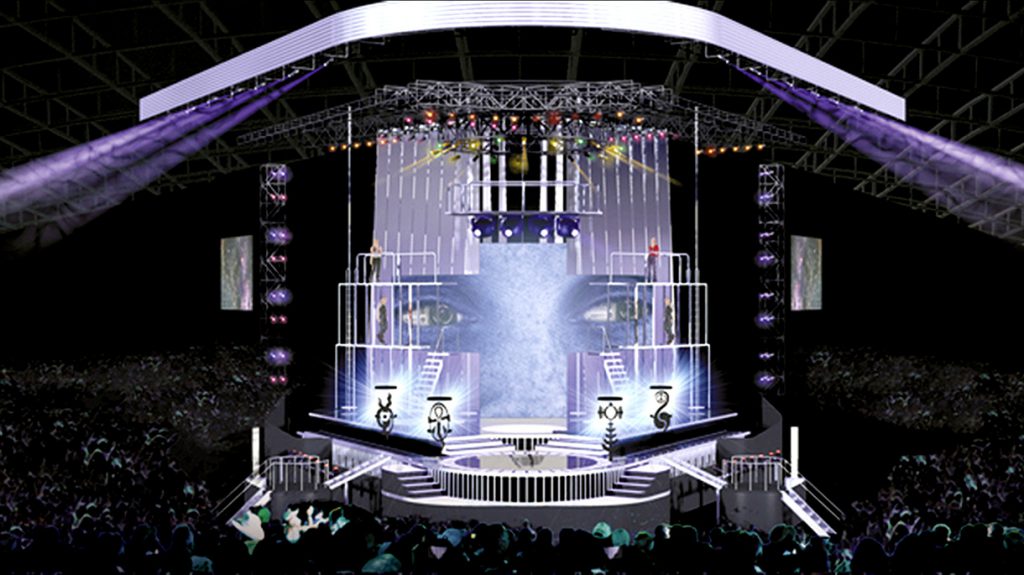
Ricky Martin, Livin’ La Vida Loca Tour 1999
We remember reading that you were inspired to use a portrait of Ricky Martin as the centerpiece of the production design for his Livin’ La Vida Loca tour after you saw a picture of him on the cover of Rolling Stone while waiting in line at the grocery store. Can you elaborate a bit on how that happened?
“I got a call from the director Jamie King to throw them a concept a few weeks after Ricky’s big splash performance on the Grammys. I was in Washington, D.C. on a gig with Ted Koppel’s Nightline when I got the call. Jamie told me the job was between me and the photographer Richard Avedon, fashion designer Armani and a couple others. I was in the Mayflower Hotel that week and the concept was due in a few days when I saw the Rolling Stones cover with Ricky’s face. It was an easy concept to break down and recreate in 3D staging. I got the job based on the idea and a meeting with Ricky where I explained that on face value he was clearly a star, but the exciting part was what was inside – the clever and interesting things we could design within this setting to show how deep he was spiritually and musically. That was such an amazing world tour with 15 different automation effects above and below the stage, including a car that ppoped up at the nose of the stage with Ricky standing on top… and a great cast of performers and musicians.”
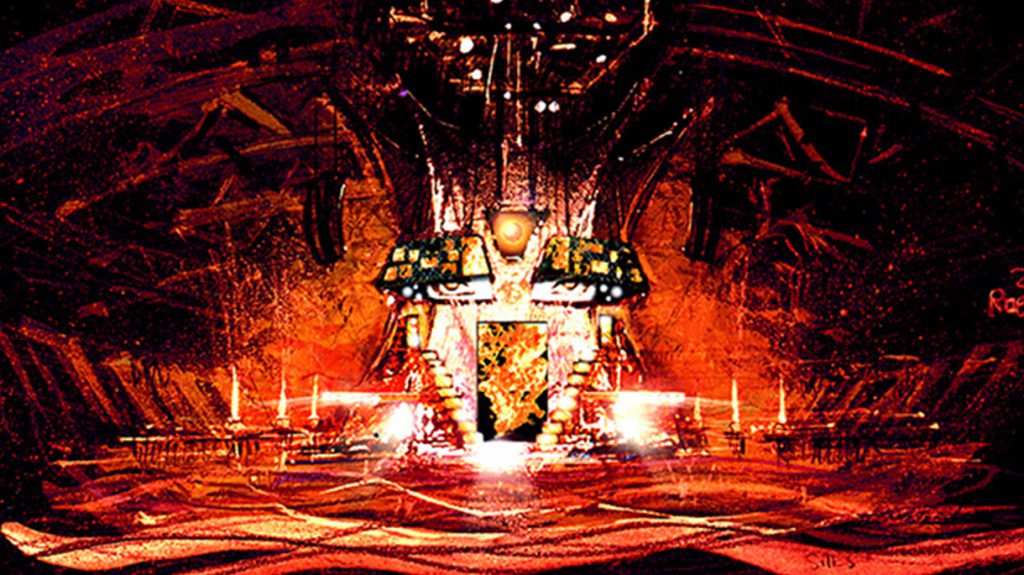
Madonna, Drowned World Tour 2001
What were the highlights you remember about designing Madonna’s Drowned Tour?
“The tour design with Madonna followed Ricky’s tour. She saw his show and hired us all, and it was a super exciting process! I love Madonna and learned so much processing a design with her. It started with a face-to-face meeting where she gave me the names of the 5 scenes of the show she had in mind and my job was to come back with a concept that showcased each scene inside an overall production design. Obviously, I was inspired and came back with a ton of sketches that laid out the show from top to bottom, including the show opener with the lighting rig sitting on the stage floor and slowly flying up as if a space ship had landed and delivered her to the arena. We broke the Nocturne video screen technology into tiles and blended them onto a caged rig of light and smoke effects and managed to lift it all with the help of the great rigger Joe Branam. The thing I remember most is the way Madonna drove the process with respect and seriousness, and always drove forward perfecting along the way. She worked harder than anyone and never retreated or started over in the process. It was amazing working with Jerry Stickles, Peter Morse, Arnold Serame, Chris Lamb, Jamie King, Tiffany Olson, Dago Gonzales, John McGraw, Brian Sullivan, Erik Eastland, All Access and many others on that show design.”
How do you get inspired at the start of a project?
“Our Connecticut studio is attached to our house. I work with Shelley and we make a playlist of the artist’s music and collected music from other artists in the current and distant past that we decide is fitting. The list becomes the only soundtrack in our house for a couple weeks. And we sketch and gather imagery and discuss and debate and argue until we love our own ideas. We then fold in our support team to start building the sketch ideas into 3D visuals.”
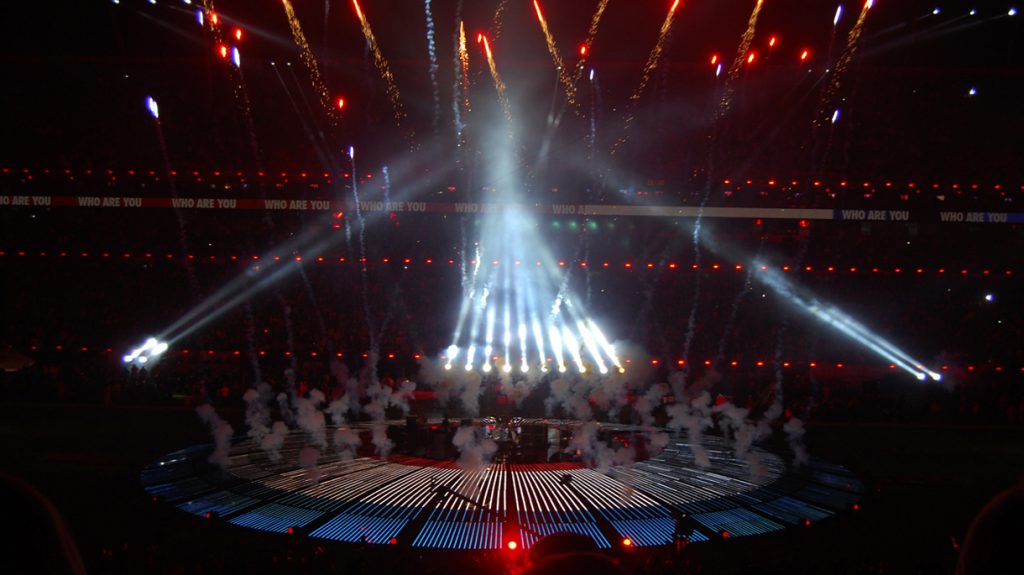
The Who, Superbowl Halftime Performance 2010
What is the most dangerous mistake to avoid as a production designer?
“I like dangerous mistakes. Being safe clogs the creative flow. There’s really no single method to creation, especially in the music design world. But the best approach is to remember you’re not the star, but your job is to get inside the artist to design purely based on their message.”
Is there one project in your career that you regard as the most pivotal – or the biggest learning experience? I don’t necessarily mean the most important or favorite, but the one that had a big influence over the course of your career?
“I’d say the ones that mean the most are between the Prince Halftime Show, Barack Obama’s Nomination Speech at Invesco Field in Denver and his Election Night Speech at Grant Park, Chicago. We sometimes need guidance from people like them to help us elevate, and I rely on those memories sometimes to keep me going.”
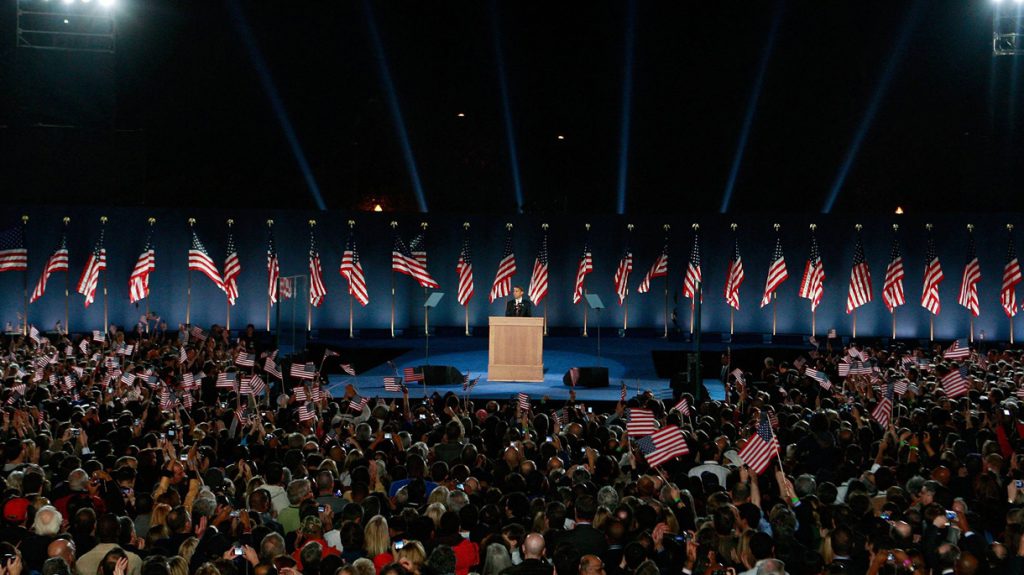
Barack Obama, Presidential Election Victory Speech 2008